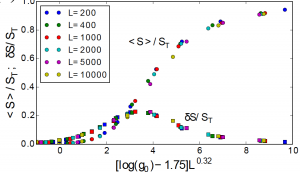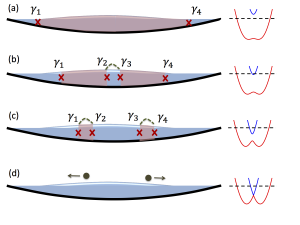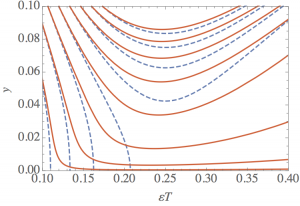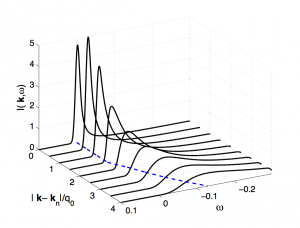This web site is outdated, but retains information on older research projects.
Please visit my new site for summary of more recent research.
I am working on the theory of strongly correlated quantum matter, where the interplay of interactions and quantum entanglement between the particles can give rise to unexpected emergent properties. A recent focus of our research has been on emergent behavior of non equilibrium quantum systems. For example we are trying to gain deeper insight into how closed many-body systems thermalize and thereby lose all observable quantum correlations. At he same time we explore possible failures of thermalization, as exemplified in the phenomenon of many-body localization.
Here are brief summaries of a few research topics. For more details and specific results in each of the topics click on the titles.
Many Body Localization and quantum thermalization

At the simplest level many-body localization (MBL) is the extension of Anderson localization to a many-body interacting system. An MBL system fails to reach thermal equilibrium when evolving under its own dynamics, and is the only known generic alternative to ergodic time evolution. While ergodic dynamics is associated with emergent classical behavior, in MBL systems quantum correlations play a crucial role at arbitrary long time scales. This is related to the fact that not only matter and energy are localized in the MBL state, but also quantum information remains partially localized. Much of my recent work has been devoted to understanding the nature of the dynamics in the MBL state, characterizing the phase transition between this state and an ergodic fluid and gaining insight into the process of thermalization in quantum systems. I also collaborate with experimental groups trying to investigate these fascinating phenomena using systems of ultra-cold atoms.
The figure to the right is an example from our work on the MBL transition with Ronen Vosk and David Huse. It shows finite size scaling of the entanglement entropy change across the critical point, exhibiting a universal jump within our theory of the critical point. For more on MBL click here.
Strongly correlated states of ultra-cold atomic systems

Ultra-cold atomic systems offer an interesting new laboratory to study the organization of quantum matter. The unique aspects of these systems sometimes require us to critically revisit central concepts developed in the context of other systems, thus leading to new insights. For example, unlike traditional solid state systems it is natural to realize Bose insulators in atomic systems. This has prompted us to ask, early on, what would constitute a topological variant of a Bose insulator. Unlike a topological band insulator of fermions, does not have a non-interacting limit. Together with Berg, Giamarchi and Dalla Torre, we found a 1d topological Bose insulator and identified the symmetries required to distinguish it from the trivial Mott state. This was Before the term “symmetry protected topological phase” (SPT) was introduced.
More recently we have characterized topological states of interacting fermions with effective spin orbit interaction. The figure to the right illustrates a pumping experiment proposed to reveal the topological character of the state.
We investigate many other quantum states that can be naturally studied with ultra-cold atomic systems. Examples include condensates of bosons on frustrated lattices that lead to extensive degeneracy of the non interacting dispersion (condensation on flat bands); The quantum phases and phase transitions of interacting bosons in strong disorder; Mott insulators of Bose-Fermi mixtures and more. For more details on this topic please click here.
Novel states of driven systems
 In recent years there has been substantial progress in experiments with many-body quantum systems strongly coupled to light. A case in point are fluids of exciton-polariton excitations of semiconductor quantum-wells in an optical cavity. Pumping with light to overcome photon loss, drives these many-body systems into a non-equilibrium steady states which we seek to understand. These are some of the questions we attempt to address: can the classification of equilibrium phases of matter be generalized to driven steady states; Do phase transitions exist in such systems, and if so how do we characterize them? Can a scaling approach be applied? Can quantum interference effects survive and dominate certain states of driven systems?
In recent years there has been substantial progress in experiments with many-body quantum systems strongly coupled to light. A case in point are fluids of exciton-polariton excitations of semiconductor quantum-wells in an optical cavity. Pumping with light to overcome photon loss, drives these many-body systems into a non-equilibrium steady states which we seek to understand. These are some of the questions we attempt to address: can the classification of equilibrium phases of matter be generalized to driven steady states; Do phase transitions exist in such systems, and if so how do we characterize them? Can a scaling approach be applied? Can quantum interference effects survive and dominate certain states of driven systems?
Figure: RG flow describing vortex unbinding in 2d exciton-polariton condensates. While at short scales this looks like Kosterlits-Thouless physics of a 2d superfluid vortices ultimately unbind at long scales due to non-equilibrium fluctuations.
Quantum materials
 Experiments with novel materials with strong electron correlations reveal a host of surprising behavior at low temperatures that seem to defy the conventional paradigms of Fermi-liquids, magnetism or superconductivity.
Experiments with novel materials with strong electron correlations reveal a host of surprising behavior at low temperatures that seem to defy the conventional paradigms of Fermi-liquids, magnetism or superconductivity.
In this area I have considered the unexplained properties of the high Tc cuprate superconductors. I have worked on models of the unconventional normal state found in the underdoped regime, providing in particular a possible explanation of the mysterious Fermi arcs. The Figure to the right shows, for example, a calculation of ARPES spectra exhibiting such Fermi arcs. Other questions I investigated include emergent magnetic properties at interfaces between oxide insulators and transport on the surface of topological insulators. For more information on these topics click here.